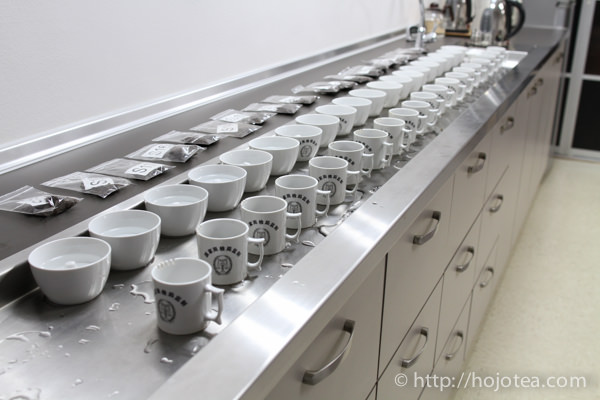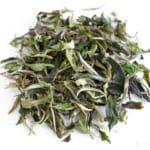- HOME >
- How to choose quality tea
The Intimate Relationship Between Body and Calcium
One of the indexes to evaluate the quality of tea is the body. Body is a term often used to describe the taste, yet I think very few people precisely comprehended it well. The word “body” can be described as boldness, width, and heaviness. Basically, it is the term that describes the taste and flavour that spread horizontally on our palate, while the after taste describes the vertical feeling (i.e., down our throat) in taste and flavour. Even in many books written by food scientists, the term “body” is wrongly used, where it often describes the heavy texture of the taste and flavour. I would like to introduce the typical mistakes as follow:
- Red wine has more body than white wine
- Milk shake has more body than milk
- Addition of starch in soup increases the body
- Fukamushi Sencha (Deep Steamed Sencha) has more body than Sencha
Calcium plays an important role in body
The body of tea does not reflect the method tea was grown or processed, but is of the soil from each location. In particular, the calcium level in soil plays an important role, where the production area that is rich in calcium generally produces tea with strong body. Commonly, the tea that gives strong body is appreciated by the beginner as well. It gives rounded taste and out-coming flavour. This is why, tea from famous production areas tend to have very rich calcium content; making it popular thanks to the full-bodied characteristic.
The famous tea production areas that are rich in calcium
- Dong Ding mountain where Taiwan Dong Ding Oolong is produced
- Lao Ban Zhang and Bu Lang Shan tea area in Yunnan
- Asamiya from Shigaraki in Japan
- Singbulli Ting Ling district in Darjeeling, India
The body can be the index to understand the production area
Naturally, other agricultural products being produced in the same area give the similar characteristic in terms of body; for instance, the Asamiya tea gives strong body. If we look for Sake or fruits produced in Asamiya area, they will produce an identical characteristic as the Asamiya tea in terms of body. Asamiya is a place in Shigaraki city, where it is also famous for its clay called the Shigaraki clay. Besides, we also found another type of clay from this area, which is called the Kobiwako clay. We have teapots made from this clay collected from these areas. Both the Shigaraki and Kobiwako clay from this area gives strong body to the tea. Based on my experience, the taste of water in Shigaraki, Dong Ding mountain area and Bu Lang Shan also has strong body; similar to the taste of tea from these areas. After all, the body is an useful index to understand the characteristic of each production area.
Related Articles
How to get the latest update on HOJO?
1. Follow Twitter, 2. Click "Like" on Facebook, and 3. Subscribe in newsletter. You can have the latest tea news from HOJO.
 Subscribe the Newsletter to enjoy the privileges
Subscribe the Newsletter to enjoy the privileges- You may receive a free sample upon purchase, or you may have the priority to purchase special products. So please remember to subscribe our newsletter as well as the social network.
- Fresh 2025 Yunnan White Tea – Select Your Favourite Lot Before Blending
- Freshly crafted in Yunnan and just arrived in KL, our new 2025 white tea is now available at our Gardens Mall …
- 2024 Dong Shan Raw Pu-erh Tea – Crafted with the Producer for Desired Quality
- We have released the 2024 cake of Dong Shan Raw Pu-erh Tea. Earlier, we offered the loose-leaf version from th …
NEW ARTICLES
 Fresh 2025 Yunnan White Tea – Select Your Favourite Lot Before Blending
Fresh 2025 Yunnan White Tea – Select Your Favourite Lot Before Blending- Freshly crafted in Yunnan and just arrived in KL, our new 2025 white tea is now available at our Gardens Mall …
 2024 Dong Shan Raw Pu-erh Tea – Crafted with the Producer for Desired Quality
2024 Dong Shan Raw Pu-erh Tea – Crafted with the Producer for Desired Quality- We have released the 2024 cake of Dong Shan Raw Pu-erh Tea. Earlier, we offered the loose-leaf version from th …
 Development of Firewood Roasted Hojicha Using Naturally Grown Tea from Yunnan
Development of Firewood Roasted Hojicha Using Naturally Grown Tea from Yunnan- We are currently staying in Yunnan Province for tea production. As the season nears its end, tea trees with pa …
 Exploring the Food Culture of Yunnan: Where Minority and Sichuan Cuisines Meet
Exploring the Food Culture of Yunnan: Where Minority and Sichuan Cuisines Meet- We are currently staying long-term in Yunnan Province for spring tea production. On rainy days or when there i …
 New Arrival of Akitsu Mumyoi and Nosaka Rough Clay Teapot
New Arrival of Akitsu Mumyoi and Nosaka Rough Clay Teapot- A wide selection of teaware by Watanabe Tozo, a Sado-based artist of Mumyoi-yaki, has just arrived. This time, …
 Managing Yunnan White Tea — Insights from the Field
Managing Yunnan White Tea — Insights from the Field- Since March 25, we have been in Yunnan Province, fully engaged in the production of white tea. In this column, …
 Mang Fei Ripe Pu-erh Tea 2023 – Small-Batch Production from a Renowned Region
Mang Fei Ripe Pu-erh Tea 2023 – Small-Batch Production from a Renowned Region- Mang Fei Ripe Pu-erh Tea 2023 is now available. This is one of the highest-quality ripe pu-erh teas among our …
 Yunnan Tea Trends 2025: Insights from the Fields
Yunnan Tea Trends 2025: Insights from the Fields- Since March 25, we have been in Yunnan Province. We will stay here until May to conduct tea production, packin …
 Why Do Some Teas Taste Astringent? Exploring the Causes and Mechanisms of Astringency
Why Do Some Teas Taste Astringent? Exploring the Causes and Mechanisms of Astringency- Tea can range from having no noticeable astringency to possessing a very strong one. What causes this astringe …
 The Impact of Heat Sources on Tea Flavor
The Impact of Heat Sources on Tea Flavor- It is widely recognized that the material of a kettle plays an important role in shaping the taste of water fo …
Category
- New Arrival at HOJO Online Shop
- Featured Articles
- Newsletter
- Types of Tea
- Origin of Tea
- Teapot and Tea Equipment
- Tea Column
- How to enjoy tea
- Tea Processing
- How to choose quality tea
- Tea constituents and functional effect
- Safety of Tea
- Foods
- Tea Business Operation
- Hobby and Outdoor Activity
- Ranking of Tea
- Video
- FAQ
- Media Release
Profile

- AKIRA HOJO
- I invite you to experience my tea selections.I was born in Nagano, Japan. In university, I studied agricultural chemistry, and I have the master degree in food science. I worked in Japanese food industry for 10 years. I involved in R&D, QC and QA. As a factory manager, I implemented ISO9000 series and managed the factory.
- The Art of Tea Magazine
- We posted the article on “The Art of Tea Magazine No.9, the magazine is published in Taiwan. We featured …
- New Straits Times
- The Malaysian National Newspaper, New Straits Times featured HOJO Tea on 17-Oct-2007.
Shop Info

Address:Lot No. T-215, 3rd Floor, The Gardens Mall, Mid Valley City, Lingkaran Syed Putra, 59200 Kuala Lumpur
Tel: +603-2287-4537
Business Hour: 10am to 10pm















